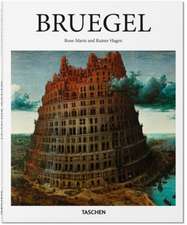Reading Texts And Images: Essays on Medieval and Renaissance Art and Patronage
Editat de Bernard J. Muiren Hardback – iul 2002
This book is a collection of specially-commissioned art-historical essays on the theme of manuscript studies by some of the world's leading art historians and curators of manuscripts. It is expected to be even more successful and well-received than the comparable volume from University of Exeter Press, The Art of the Book: Its Place in Medieval Worship, edited by Margaret M. Manion and Bernard J. Muir.
The contributors are writing on their particular area of manuscript study, with the Wharncliffe Hours and the Book of Kells among the important manuscripts discussed. Their essays are written in honour of Margaret M. Manion, Professor Emeritus, Department of Fine Arts, University of Melbourne. Margaret Manion has an international reputation for her work in the field of art history. Her many publications include a facsimile edition of The Wharncliffe Hours (Thames & Hudson) and Medieval and Renaissance Illuminated Manuscripts in Australian Collections (with Vera F. Vines, Thames & Hudson).
Preț: 848.33 lei
Preț vechi: 1162.10 lei
-27% Nou
Puncte Express: 1272
Preț estimativ în valută:
162.32€ • 169.94$ • 134.32£
162.32€ • 169.94$ • 134.32£
Carte tipărită la comandă
Livrare economică 05-19 aprilie
Preluare comenzi: 021 569.72.76
Specificații
ISBN-13: 9780859897136
ISBN-10: 0859897133
Pagini: 320
Ilustrații: 100 ills and 16 colour plates
Dimensiuni: 254 x 185 x 30 mm
Greutate: 1.18 kg
Editura: Liverpool University Press
Colecția Liverpool University Press
Locul publicării:United Kingdom
ISBN-10: 0859897133
Pagini: 320
Ilustrații: 100 ills and 16 colour plates
Dimensiuni: 254 x 185 x 30 mm
Greutate: 1.18 kg
Editura: Liverpool University Press
Colecția Liverpool University Press
Locul publicării:United Kingdom
Notă biografică
Bernard Muir is Reader in Medieval Language and Literature in the English Department, University of Melbourne. His publications include The Exeter Anthology of Old English Poetry (Exeter) and A Pre-Conquest English Prayerbook (Boydell).
Cuprins
Tribute to Margaret M. Manion by Peter Steele SJ, Professor of English, University of Melbourne
1) Janet Backhouse, [Former] Assistant Keeper at the Department of Manuscripts and Curator of Illuminated Manuscripts, The British Library
Margaret Beaufort’s Italian Manuscript of the Name of Christ Devotions
2) Dagmar Eichberger, Lecturer in Art History at the Universities of Saarsbrücken and Heidelberg
The Dance of Death in Art: Visual Representations of Men, Women and Children in Renaissance Society
3) Bernard Muir, Reader in Medieval Language and Literature, University of Melbourne
Towards Interpreting the Iconography of the Gospel of St Luke in the Book of Kells
4) Joan Barclay-Lloyd, Lecturer in Art History, LaTrobe University, Melbourne
The River of Life in the Apse Mosaics of S. Maria Maggiore in Rome
5) Thomas Kren, Curator of Manuscripts, The J. Paul Getty Museum, Los Angeles
A Scribe and a Prayerbook: a New Approach to the Wharncliffe Hours
6) Lucy Freeman Sandler, Helen Gould Sheppard Professor of Art History, New York University
The Illustration of the Psalms in Fourteenth-Century English Manuscripts: The Case of the Bohun Family Psalters
7) John Stinson, Music Faculty, La Trobe University
The Rimini Antiphonal: palimpsest music and Renaissance liturgical practice
8) Louise Marshall, Department of Art History and Theory, University of Sydney
Reading the Body of a Plague Saint: Narrative Altarpieces and Devotional Images of St. Sabastian in Renaissance Art
9) Rodney Thomson, Emeritus Professor of Art History, University of Tasmania
Minor Manuscript-Decoration from the West of England in the Twelfth Century
10) Nigel Morgan, Professor of Medieval Art History, University of Oslo
Patrons and Devotional Images in English Illumniated Manuscripts of the International Gothic
11) Christopher de Hamel, Librarian, Corpus Christi College, Cambridge
New Observations on the Dutch Bible (c.1419) in Auckland Public Library
12) Jonathan Alexander, Professor of Art, Institute of Fine Arts, New York University
Sacred and secular in the Wharncliffe Hours
13) Gerard Vaughan, Director, National Gallery of Victoria
An Eighteenth-Century Classicist’s Medievalism: The Case of Charles Townley








